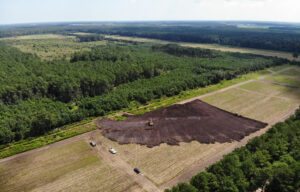American Black Duck Conservation Plan
The American Black Duck was once the most abundant dabbling duck in eastern North America. Black duck populations began declining steadily in the 1950s and reached an all-time low by the 1980s, having lost more than half of their historical population. Populations have stabilized since then, but they remain below North American Waterfowl Management Plan (NAWMP) objectives. The goal of the Joint Venture is to sustain the current population of Black Ducks and the Black Duck Working Group is currently working on a conservation plan to achieve this goal. Working Group members met several times over the past year to identify threats and develop six priority conservation strategies aimed at restoring, enhancing and creating suitable Black Duck habitat along the Atlantic Coast. We expect to finalize the Black Duck Plan by the fall of 2021.
 Black Duck Decision Support Tool Expansion
Black Duck Decision Support Tool Expansion
To understand Black Duck wetland habitat requirements during the non-breeding period, the ACJV, Black Duck Joint Venture, Ducks Unlimited, and many other partners developed the American Black Duck Decision Support Tool (DST). The initial version of the DST focused on the Mid-Atlantic/New England region where most black ducks are found during winter. Ducks Unlimited is currently working on expanding the DST to encompass the entirety of the Black Duck non-breeding range including the south Atlantic region of the ACJV, southern Eastern Habitat Joint Venture, Appalachian Mountains Joint Venture, Upper Mississippi Great Lakes Joint Venture and Central Hardwoods Joint Venture.
The goal is to provide specific wetland restoration and protection acre goals to help achieve the NAWMP Black Duck population objective. The DST will help guide black duck conservation efforts by prioritizing small scale watersheds for restoration and protection actions. Through this tool, land managers will be able to determine the best way to contribute to achieving black duck goals across their non-breeding range.
Outreach for Black Ducks on the Delmarva Peninsula

Creating shallow wetlands on former agricultural lands is a popular practice with private landowners, and benefits American Black Duck and other migratory birds. Mike Dryden/TNC
In 2020, ACJV partners wrapped up a two-year outreach effort on the Eastern Shore of Maryland, funded in large part by a Habitat Goal Implementation Team grant from the EPA Chesapeake Bay Program. This project allowed The Nature Conservancy to host a full-time outreach position focused on encouraging private landowners to sign up for Farm Bill programs and take advantage of NRCS’s “Working Lands for Wildlife” Black Duck Initiative (which covers NJ, DE, MD, and VA). This project successfully raised the profile of ACJV efforts to conserve habitat that benefits not just American Black Duck but also Saltmarsh Sparrow and Black Rail, especially because partners agreed that the effort should focus on conserving the marsh migration zone. This project greatly increased coordination among many ACJV partners on the Delmarva, including NRCS, state wildlife agencies (DE and MD), Audubon, TNC, and DU. As a result of this project, four properties in high-priority areas were enrolled in Farm Bill programs, comprising 194 acres to be restored, plus another 130 acres of wetlands are in the contract phase, with easements planned to close in 2021 and construction to follow in the next phase. Although the project funding has run out, TNC, USFWS, and NRCS continue to work with private landowners, including construction of a 120 acre restoration project on the Pocomoke River, although direct outreach has been put on hold due to COVID. NRCS is in the process of onboarding a new biologist on the Eastern Shore of Maryland who will focus on planning and managing wetland restoration work and enrolling landowners in the ACEP Wetland Reserve Easements program.



